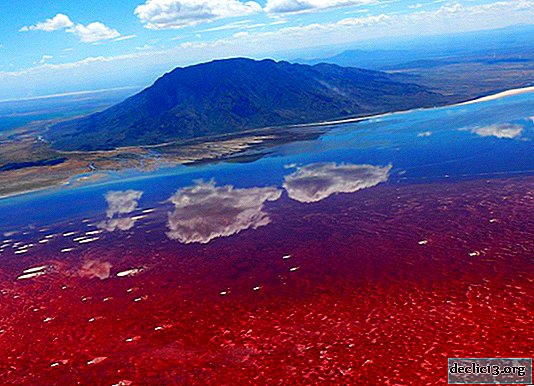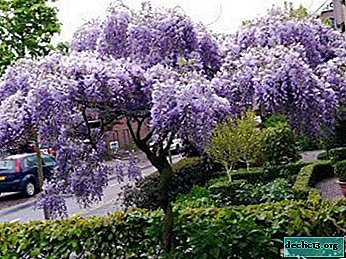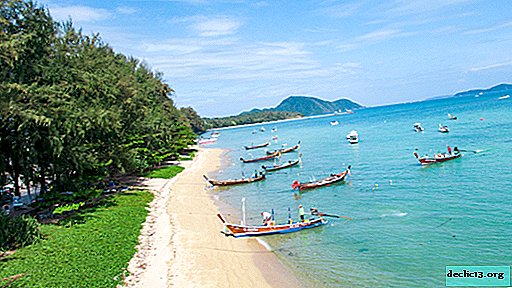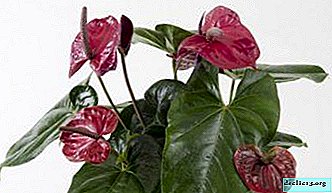Natron - The Deadly Lake in Tanzania
Lake Natron is one of Tanzania's most famous natural attractions. It is famous for the fact that the water in the lake has a bright red color, and the birds that once flew over this place turn into salty stones. The masses became aware of the existence of an unusual reservoir relatively recently: a few years ago photos of Lake Natron in Tanzania were published in a British magazine.

General information
Natron is the most saline and alkaline reservoir not only in East Africa, but also in the world, and the characteristic muddy red color is just a dense crust of salt that covers the lake. Due to the global environmental changes that are taking place in the world, in the near future there is a great threat that the salt balance may be disturbed in the unique composition of the Natron. And this can lead to the extinction of unique microorganisms living in the pond.

The lake is located near the border of Tanzania with Kenya, and covers an area of slightly less than 1040 sq.m. It reaches no more than 57 km in length and about 21 km in width. In the warmest months, the temperature of the water in the pond can exceed 50-60 ° C. The average depth of the Natron is 1.5 meters, and in the deepest places - 3 meters. A tributary of the lake is the Evaso Ngiro River, which originates in northern Kenya.
Flora and fauna

Lake Natron is home to only 3 species of microorganisms, as well as the birthplace of 75% of flamingos living on Earth. For “sunset children” this is an ideal place - because of the increased salt balance, predators and other birds try not to get close to the lake. By the way, in order to see flamingos in Tanzania, it is better to fly to Natron in the summer - this is the breeding season in birds.
Only one species of fish can live in the lake itself - alkaline telapias. Over many millennia, they have adapted to harsh and dangerous conditions, and today Natron is the only place in the world where this species lives.
Due to its unique biodiversity, the lake was included in the list of unique places following the Ramsar Convention and is included in the East African World Wide Fund for Nature.
Today, scientists around the world are opposed to the construction of a plant for the production and extraction of potash (later made of detergent from it) near the lake - such an unfavorable neighborhood can adversely affect the salt balance in the reservoir and the inevitable disappearance of small flamingos in Africa. However, the indigenous people of Tanzania have a different truth: the factory could provide housing and work for more than 1000 people.

By the way, the only people who live in these places are representatives of the ancient Salei tribe. They consider the lake a manifestation of divine power, and wander their whole life along the shores of a salt reservoir.
Thus, even though the construction of the plant was suspended, there is still a threat of extinction of the salty part of the lake. This may be due to increased inflows and the possible construction of a new hydroelectric power station on Lake Evaso Ngiro.
Lake phenomenon
For many scientists, Natron in Tanzania is still a mystery. And if everything is clear with color (due to the high amount of salts, a red-pink crust forms), then not everyone can explain another phenomenon (Lake Natron turns animals into stones).

The bird cemetery became known thanks to naturalist photographer Nick Brandt, who first published pictures of frozen birds in his journal “On the devastated Earth”. At first he was accused of being a staged photo shoot, but after some time, the researchers nevertheless confirmed the veracity of these photos. After that, photos of Lake Natron began to spread rapidly, and Tanzania became a fairly popular tourist destination.
Many scientists explain the phenomenon of stone birds near Lake Natron in Tanzania as follows: due to the fact that the water temperature in some places reaches more than 60 ° C, and the water is very salty and alkaline, the birds do not decompose when they enter the lake, but freeze forever .

The only thing that biologists have not yet found an explanation for is why birds fly into the water. The most popular version: due to the increased reflective ability, birds lose their orientation, and, taking water for the sky, fly at full speed down. Although there are other opinions: for example, some researchers believe that all the birds died their death, and they covered with salt after. However, photographer Nick Brandt, who has visited these places more than once, refutes this assumption.
But be that as it may, the lake killer Natron is dangerous for people: here you should not only swim, but even touch the water, because you can simply get burned. In addition, it is not known to the end what effect hot alkaline water can have on the human body - scientists are not in a hurry with experiments and conclusions.

Depending on the season, Lake Natron may look different: in the summer it dries up, and the earth, where there used to be water, is covered with huge cracks with salt. Seasonal showers in this part of Tanzania begin in August - September and last until December. The color of the water changes depending on the bacteria that activate in certain months of the year.
How to get to the lake from Arusha
 Arusha
ArushaArusha, the closest town in Tanzania, is 240 km from the lake. You can get from it to a unique attraction on the local bus, which will go for four and a half hours. There are no trains in these parts, as there are no separate excursions to the lake. However, you can buy a tour to the volcano Ol Doinho Lengai, which also includes a visit to the Natron. At the foot of the volcano there are many campsites.
Compare accommodation prices using this form
You can get to Arusha from: Kenyan Nairobi (4 hours), Dodoma (6 hours) in Tanzania and Dar es Salaam (9 hours on the way). The nearest airport is 50 km from Arusha.
Getting to Arusha and beyond is quite difficult and expensive, and this must be taken into account when planning a trip. But, as many tourists say, Lake Natron is so unique and unusual that it is definitely worth the money and effort.

















